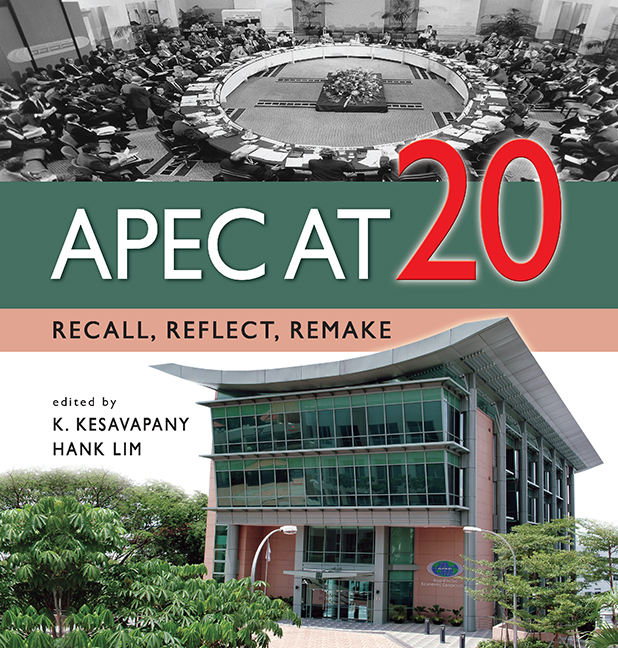Book contents
- Frontmatter
- Frontispiece
- contents
- Foreword by Ambassador Michael Tay
- Preface
- About the Authors
- Asia-Pacific Economic Cooperation (APEC)
- CHAPTER 1 APEC: Genesis and Challenges
- CHAPTER 2 APEC's Origins and its Future
- CHAPTER 3 Four Adjectives Become a Noun: APEC The Future of Asia-Pacific Cooperation
- CHAPTER 4 APEC's Eye on the Prize: Participants, Modality, and Confidence-Building
- CHAPTER 5 APEC: Taking Stock and Looking Ahead
- CHAPTER 6 Revamping APEC's Concerted Unilateral Liberalization
- CHAPTER 7 APEC at 20: Assessment of Trade/Investment Liberalization, Facilitation and Ecotech Activities
- CHAPTER 8 Integrating the Business Community in the APEC Process: Genesis of the Pacific Business Forum
- APPENDICES
- Index
CHAPTER 1 - APEC: Genesis and Challenges
from Asia-Pacific Economic Cooperation (APEC)
Published online by Cambridge University Press: 21 October 2015
- Frontmatter
- Frontispiece
- contents
- Foreword by Ambassador Michael Tay
- Preface
- About the Authors
- Asia-Pacific Economic Cooperation (APEC)
- CHAPTER 1 APEC: Genesis and Challenges
- CHAPTER 2 APEC's Origins and its Future
- CHAPTER 3 Four Adjectives Become a Noun: APEC The Future of Asia-Pacific Cooperation
- CHAPTER 4 APEC's Eye on the Prize: Participants, Modality, and Confidence-Building
- CHAPTER 5 APEC: Taking Stock and Looking Ahead
- CHAPTER 6 Revamping APEC's Concerted Unilateral Liberalization
- CHAPTER 7 APEC at 20: Assessment of Trade/Investment Liberalization, Facilitation and Ecotech Activities
- CHAPTER 8 Integrating the Business Community in the APEC Process: Genesis of the Pacific Business Forum
- APPENDICES
- Index
Summary
Introduction
Some of the foundations of APEC were laid more than 40 years ago. Careful consensus building, based on the achievements of ASEAN and PECC made it possible to launch APEC, based on agreed principles, in 1989. The process evolved quickly in its early years; by 1994 APEC leaders set themselves the remarkably ambitious objective of free and open trade.
Much has been achieved since then, but there have also been some disappointments. The first Bogor deadline of free and open trade and investment for developed APEC economies by 2010 will not be met.
Learning from experience, APEC now needs to act in line with the comparative advantage of a voluntary process of cooperation, rather than attempt to become a negotiating forum.
Some traditional border barriers remain. But the negotiations needed to reduce them can be left to the forums designed to conduct them. That would allow APEC to concentrate on issues which are of considerably greater concern to most of those involved in international commerce. These are practical matters like logistic constraints, inadequate communications, security concerns and the need to cope with different regulations in other economies.
APEC governments are already cooperating effectively in these areas. The constraints are lack of capacity, rather than political will. Voluntary cooperation has been proved to be feasible in these areas, but much more can be done.
APEC leaders could raise the profile of such important work by setting longterm targets in specific practical areas discussed in this paper. Achieving ambitious, but realistic, milestones on the way to such targets would allow APEC to transform itself to a process which records a sequence of realistic, ambitious and practical achievements, year after year.
Sadly, this is may not be possible. Instead of steady progress in line with the founding concepts of voluntary cooperation and open regionalism, many years may be wasted in an attempt to negotiate a lowest common denominator, APEC-wide trading bloc.
- Type
- Chapter
- Information
- APEC at 20Recall, Reflect, Remake, pp. 1 - 16Publisher: ISEAS–Yusof Ishak InstitutePrint publication year: 2009

